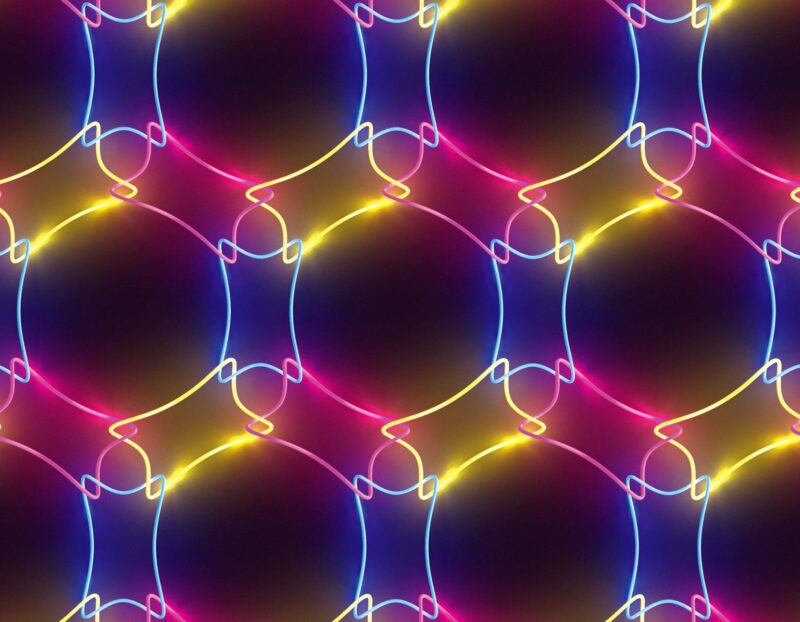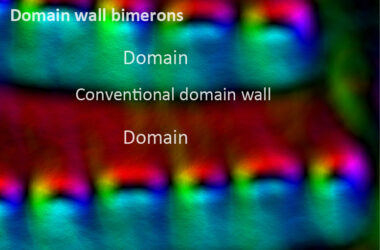
Diagramme de liaison de l’électronique quantique dans l’espace du moment (vitesse) observé dans l’aimant topologique de Weyl Co2MnGa, déterminé à partir de mesures de spectroscopie de photoémission avancée. Crédit : Ilya Belopolski et M . Zahid Hasan, Université de Princeton
Les électrons dans un cristal présentent des torsions quantiques liées et nouées
Au fur et à mesure que les physiciens s’enfoncent dans le domaine quantique, ils découvrent un monde infiniment petit composé d’un ensemble étrange et surprenant de liens, de nœuds et d’enroulements. Certains matériaux quantiques présentent des tourbillons magnétiques appelés skyrmions – des configurations uniques parfois décrites comme des “ouragans subatomiques”. D’autres abritent une forme de supraconductivité qui se tord en tourbillons.
Maintenant, dans un article publié dans le journal Nature, une équipe de scientifiques dirigée par Princeton a découvert que les électrons de la matière quantique peuvent se lier les uns aux autres de manière étrange. Ces travaux rassemblent des idées dans trois domaines scientifiques – la physique de la matière condensée, la topologie et la théorie des nœuds – d’une manière nouvelle, soulevant des questions inattendues sur les propriétés quantiques des systèmes électroniques.
La topologie est la branche des mathématiques théoriques qui étudie les propriétés géométriques qui peuvent être déformées mais pas intrinsèquement modifiées. Les états quantiques topologiques ont attiré l’attention du public pour la première fois en 2016, lorsque trois scientifiques, dont Duncan Haldane, qui est le professeur de physique mathématique Thomas D. Jones et le professeur de physique de l’université Sherman Fairchild de Princeton, ont reçu le prix de l’ .Prix Nobel pour leur prédiction théorique de la topologie dans les matériaux électroniques.
Depuis lors, les chercheurs ont cherché à étendre ce domaine de recherche afin de créer une compréhension plus profonde de la mécanique quantique, comme dans le domaine de la “topologie quantique”, qui cherche à expliquer l’état d’un électron tel que décrit par une propriété appelée fonction d’onde. C’est le catalyseur qui a conduit à la recherche actuelle, a déclaré M. Zahid Hasan, professeur de physique Eugene Higgins à Princeton University and the senior author of the study.
“We’re studying properties related to the shape of the wave functions of electrons,” said Hasan. “And we have now taken the field to a new frontier.”
The essential building block of this new frontier is a quantum mechanical structure known as a Weyl loop, which involves the winding of massless electron wave functions in a crystal. In previous groundbreaking work, published in Science in 2019, the massless Weyl loops were discovered in a compound composed of cobalt, manganese, and gallium, with chemical formula Co2MnGa. This research was led by Hasan and included many of the authors of the new study. At that time, they understood that the massless Weyl loops produce exotic behaviors under applied electric and magnetic fields. These behaviors persisted up to room temperature.
By itself, a Weyl loop is an example of the kind of quantum wave function winding that is already well known. “Previous examples of topology in physics often involved the winding of quantum mechanical wave functions,” said Hasan, who led the current research. “These have been the focus of the physics community for at least the past decade.” These ideas are derived from the team’s earlier works on crystals made from rhodium and silicon (RhSi), as well as materials called Chern magnets made from the elements terbium, magnesium, and tin (TbMn6Sn6). Both of those discoveries were led by Professor Hasan’s group and reported in Nature in 2019 and then in Nature in 2020.
However, the case of Co2MnGa turned out to be different from wave function winding considered in conventional topological theories. “Here instead we have linked loops — our newly discovered knotted topology is of a different nature and gives rise to different mathematical linking numbers,” said Tyler Cochran, a graduate student in Princeton’s Department of Physics and co-author of the new study.
The Co2MnGa materials were grown by Professor Claudia Felser and her team at the Max Planck Institute for Chemical Physics of Solids in Germany.
An essential insight came when the Princeton team calculated and understood that certain quantum materials such as Co2MnGa could host multiple Weyl loops at the same time. “When multiple Weyl loops co-exist, it becomes natural to ask whether they can link up and knot in certain ways,” Hasan said.
This realization by Hasan’s team sparked fundamental questions about linked Weyl loops and brought together a team of experts from around the world in photoemission spectroscopy, mathematical topology, quantum material synthesis and first-principles quantum calculations to more deeply understand link topology and knotting in quantum matter.
What’s knot to like
To observe the link experimentally, the international team of researchers collaborated for more than five years to expand on their earlier works on topological magnets. The team performed advanced photoemission spectroscopy experiments at cutting-edge synchrotron radiation facilities in the United States, Switzerland, Japan, and Sweden.
“It turned out to be a fascinating puzzle that kept us hooked for a while,” said Ilya Belopolski, lead author of the study, formerly a graduate student in Hasan’s lab at Princeton University and now a postdoctoral researcher at the RIKEN Center for Emergent Matter Science near Tokyo, Japan. “Unraveling the intricacies of this elaborate linked quantum structure itself required more than three years of high-precision and ultra-high-resolution measurements at the world’s leading spectroscopic facilities.”
Analysis of the experimental data revealed a counterintuitive object folded in on itself and wrapping across a higher-dimensional torus. “Understanding the object’s structure required a new bridge between quantum mechanics, mathematical topology and knot theory,” said Guoqing Chang, an author of the study who is now an assistant professor of physics at Nanyang Technological University in Singapore. While a former postdoctoral researcher working with Hasan at Princeton, Chang led one of the early theoretical studies of link topology in 2017 in a pioneering work in Physical Review Letters.
In fact, the research team found that existing quantum theory of materials was unable to adequately explain the emergence of this structure. But knot theory, they recognized, might hold some clues.
“We came to realize that some aspects of knot theory are very powerful in explaining quantum properties of topological materials that were not understood before,” Hasan said. “This is the first example that we know of where knot theory has been applied to understand the behavior of topological magnets. And this a very exciting!”
The findings continue and extend the decades-long conversation between physics and topology, this time bringing in new mathematical ideas to explain experiments on quantum ferromagnets. “Historically, some of the most important scientific discoveries arose when humans noticed new connections between mathematics and natural phenomena. It’s always exciting to find unexpected examples of subtle mathematics in our experiments,” Hasan said. “Even more so, it was interesting that the mathematical connection was in the field of topology, which has continued to emerge time and again in different guises in the study of quantum materials.”
The researchers intend to expand their research in multiple directions. Although Hasan and his team focused their efforts on the behavior of topological magnets, they contend that the theory has the potential of helping to explain other quantum behaviors. “We believe that knot theory can also be applied to many other topological conductors, superconductors, qubits, and many other things,” he said.
And although the researchers were not thinking about practical applications — “We were involved in fundamental research,” emphasized Hasan — their insights might help in the development of quantum computing, especially in developing new types of topological qubits.
The team of collaborators also included researchers in the Department of Mathematics at Princeton, Princeton’s Imaging and Analysis Center, the Max Planck Institute for Chemical Physics of Solids, the Paul Scherrer Institut, the Indian Institute of Technology, National Sun Yat-Sen University, the MAX IV Laboratory of Lund University, Stanford Synchrotron Radiation Lightsource at the SLAC National Accelerator Laboratory, and Lawrence Berkeley National Laboratory.
Reference: “Observation of a linked-loop quantum state in a topological magnet,” by Ilya Belopolski, Guoqing Chang, Tyler A. Cochran, Zi-Jia Cheng, Xian P. Yang, Cole Hugelmeyer, Kaustuv Manna, Jia-Xin Yin, Guangming Cheng, Daniel Multer, Maksim Litskevich, Nana Shumiya, Songtian S. Zhang, Chandra Shekhar, Niels B. M. Schröter, Alla Chikina, Craig Polley, Balasubramanian Thiagarajan, Mats Leandersson, Johan Adell, Shin-Ming Huang, Nan Yao, Vladimir N. Strocov, Claudia Felser and M. Zahid Hasan, 27 April 2022, Nature.
DOI: 10.1038/s41586-022-04512-8
The ARPES and theoretical work were supported by the US Department of Energy (DOE) under the Basic Energy Sciences program (grant no. DOE/BES DE-FG-02-05ER46200). The theoretical and experimental work at Princeton University was supported by the Gordon and Betty Moore Foundation (grant nos. GBMF4547 and GBMF9461). Materials characterization and the study of topological quantum properties were supported by the US DOE Office of Science, National Quantum Information Science Research Centers, Quantum Science Center (Oak Ridge National Laboratory), and Princeton University.



